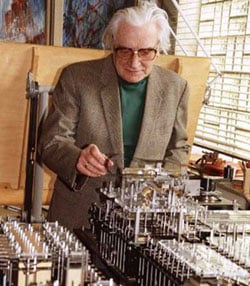History of Computers - Plankalkul
By: Maddie Clayton
Plankalkul was the first high-level computer programming language created by Konrad Zuse in 1945[1]. Plankalkul is a German word for “formal system of planning”[2].
Contents
Overview
Konrad Zuse was a German civil and computer engineer. He invented the first programmable computer with a binary code, the Z1 in 1938. During WWII, he built the Z2, an improved version of the Z1. Soon after, he constructed the Z3, the first computer to be a universal Turing Machine and therefore functional by modern standards. The fourth computer Zuse created, the Z4, gave him the idea for Plankalkul. He realized that the basic machine code was too complicated to be easily used by computer programmers, so he invented a language which would simplify the process by using words that could be translated into machine code. He named this language “Plankalkul”. Unfortunately Zuse was never able to introduce Plankalkul to the computer world because without a compiler, the language could not be used. However, it was an example for languages that are still used today.

Plankalkul is a high-level programming language. A high-level programming languages involves a more user-friendly interface than a low-level language because it simplifies the machine code into a more comprehensible mix of words and numbers, a process called abstraction[3]. The language requires a complier to translate the program into machine code, so Plankalkul, without a complier yet invented, could not be introduced to the world of technology while Zuse was alive. Some features of Plankalkul are assignment statements, subroutines, lack of preliminary variable declarations, and floating point arithmetic. Assignment statements use equal signs to store the value on the right side of the equation as the letter or word on the left side of the parenthesis[4]. A subroutine stores a function as a word so that it might be used again in the program, a function which helps simplify the code[5]. Preliminary variable declarations require the programmer to write at the beginning of the program which variables they will use. Plankalkul does not involve this step. Floating point arithmetic in relation to computers is a system of using base two and the floating binary point to show scientific notation and represent a large range of numbers[6].
Plankalkul has the following main features
1. Programs that are reusable functions (these functions are not recursive)
2. Variables are local to functions (programs)
3. Most data types are arrays, but there are also floating point, fixed point, complex numbers; records; hierarchical data structures; list of pairs.
4. The type of the variables does not need to be declared in a special header
5. The lack of a GOTO construct
6. Assignment operation (Storing a value to a variable).
7. Conditional statement (A statement that can store a value to a variable if something else is true eg. V1 = V2 => R1.)
8. The ability to define sub-programs.
9. Possibility for defining repetition of statements (loops), WHILE construct for iteration.
10. Logical operations (predicate logic and Boolean algebra).
11. Arithmetic exception handling.
Significance
Though it was never actually used, the significance of Plankalkul in computer history was that it set an example for other programming languages such as Superplan written by Heinz Rutishauser[7] and even modern languages such as C++ and Java. Without Zuse’s revolutionary ideas, programmers might be using machine code to write programs, which would be much more complex and tedious. Thus Plankalkul was a major invention in the history of computers.
Links
- http://www.zib.de/zuse/Inhalt/Programme/Plankalkuel/Plankalkuel-Report/Plankalkuel-Report.htm
- http://en.wikipedia.org/wiki/Plankalk%C3%BCl
- http://en.wikipedia.org/wiki/High-level_programming_language
- http://msdn.microsoft.com/en-us/library/z2wkh0tk(v=vs.90).aspx
- http://www.perl.com/pub/2005/11/03/subroutines.html
- http://en.wikipedia.org/wiki/Timeline_of_programming_languages
- http://en.wikipedia.org/wiki/Floating_point
http://history-computer.com/ModernComputer/Software/Plankalkul.html